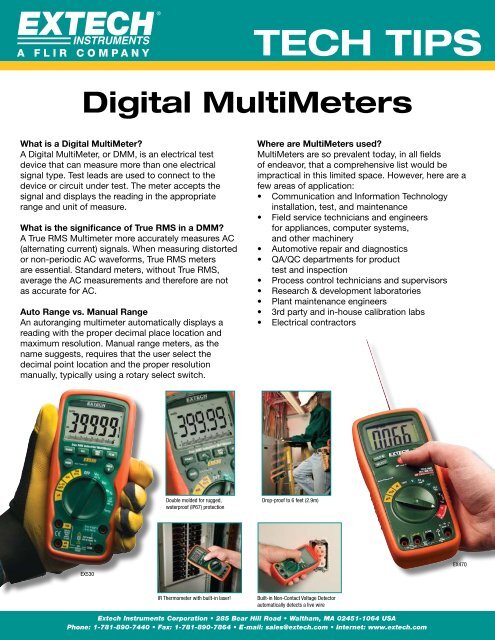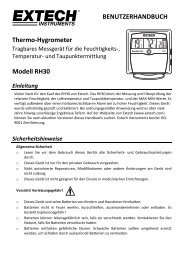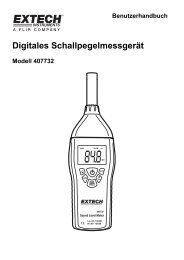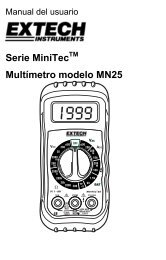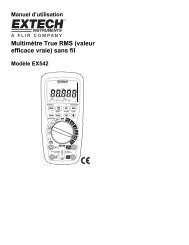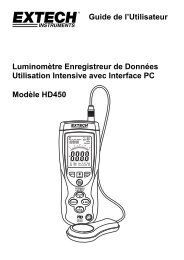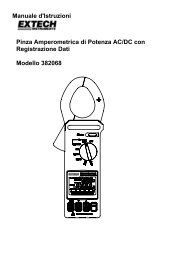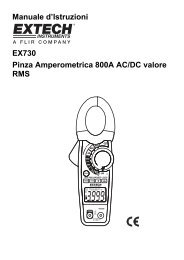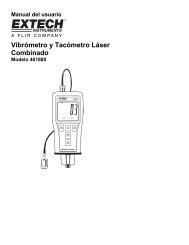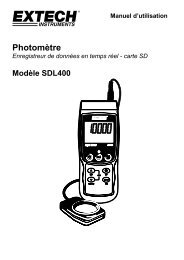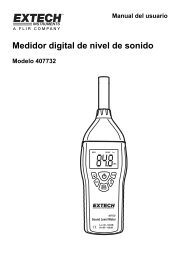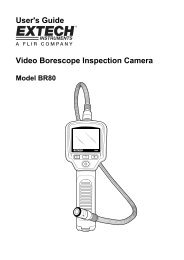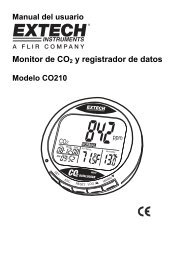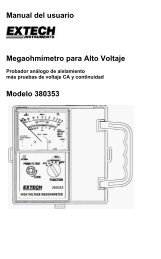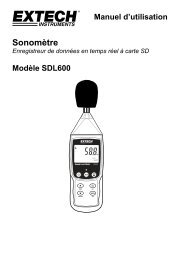TECH TIPS - Extech Instruments
TECH TIPS - Extech Instruments
TECH TIPS - Extech Instruments
You also want an ePaper? Increase the reach of your titles
YUMPU automatically turns print PDFs into web optimized ePapers that Google loves.
Te<br />
What is a Digital MultiMeter?<br />
A Digital MultiMeter, or DMM, is an electrical test<br />
device that can measure more than one electrical<br />
signal type. Test leads are used to connect to the<br />
device or circuit under test. The meter accepts the<br />
signal and displays the reading in the appropriate<br />
range and unit of measure.<br />
What is the significance of True RMS in a DMM?<br />
A True RMS Multimeter more accurately measures AC<br />
(alternating current) signals. When measuring distorted<br />
or non-periodic AC waveforms, True RMS meters<br />
are essential. Standard meters, without True RMS,<br />
average the AC measurements and therefore are not<br />
as accurate for AC.<br />
Auto Range vs. Manual Range<br />
An autoranging multimeter automatically displays a<br />
reading with the proper decimal place location and<br />
maximum resolution. Manual range meters, as the<br />
name suggests, requires that the user select the<br />
decimal point location and the proper resolution<br />
manually, typically using a rotary select switch.<br />
<strong>TECH</strong> <strong>TIPS</strong><br />
<br />
Digital MultiMeters<br />
Double molded for rugged,<br />
waterproof (IP67) protection<br />
Where are MultiMeters used?<br />
MultiMeters are so prevalent today, in all fields<br />
of endeavor, that a comprehensive list would be<br />
impractical in this limited space. However, here are a<br />
few areas of application:<br />
• Communication and Information Technology<br />
installation, test, and maintenance<br />
Field service technicians and engineers<br />
EX530<br />
IR Thermometer with built-in laser! Built-in Non-Contact Voltage Detector <br />
<br />
<br />
•<br />
•<br />
•<br />
•<br />
•<br />
•<br />
•<br />
•<br />
for appliances, computer systems,<br />
and other machinery<br />
Automotive repair and diagnostics<br />
QA/QC departments for product<br />
test and inspection<br />
Process control technicians and supervisors<br />
Research & development laboratories<br />
Plant maintenance engineers<br />
3rd party and in-house calibration labs<br />
Electrical contractors<br />
Drop-proof to 6 feet (2.9m)<br />
automatically detects a live wire<br />
EX470
What is a clamp meter?<br />
A clamp meter is a safe, convenient, and efficient<br />
way to measure current without having to use test<br />
leads. Since current flow through a conductor causes<br />
a magnetic field, the clamp meter can sense this<br />
field and provide a corresponding current reading (in<br />
amperes, or amps). Clamp meters do not interrupt<br />
current flow allowing the technician to make the<br />
measurement quickly and safely.<br />
Why True RMS Clamp-ons?<br />
A True RMS clamp meter more accurately measures<br />
AC (alternating current) signals. When measuring<br />
distorted or non-periodic AC waveforms, True RMS<br />
meters are essential. Standard meters, without True<br />
RMS, average the AC measurements and therefore are<br />
not as accurate for AC.<br />
Literature Order Form<br />
<strong>TECH</strong> <strong>TIPS</strong><br />
<br />
Clamp Meters<br />
Built-in IR Thermometer for quick<br />
and safe non-contact temperature<br />
measurements. Find hot spots fast!<br />
Applications for True RMS Clamp-On Meters<br />
• Power utility personnel for installation,<br />
maintenance, and diagnostics.<br />
• Electrical contractor supervisors and<br />
engineers and electrical journeymen<br />
• Building and facility maintenance<br />
technicians and supervisors<br />
• Manufacturing technicians and floor supervisors<br />
• Technicians for avionic electrical generation<br />
systems and ground support equipment<br />
Current Clamp Meters with DMM functionality<br />
<strong>Extech</strong> leads the market in multifunction current clamp<br />
meters. In the presence of high current flow, the need<br />
to measure volts, ohms, temperature, and frequency<br />
is imperative. Multifunction current clamp meters offer<br />
a value-added bonus for technicians, field engineers,<br />
and contractors.<br />
What is the significance of the IR thermometer?<br />
In areas where there are high current carrying<br />
conductors, safety is of utmost concern. With an<br />
IR thermometer built right into the clamp meter the<br />
technician can quickly and safely scan for ‘hotspots’<br />
on panels, conduits, and walls.<br />
EX830 EX623<br />
EX600 Series 5-in-1 meters feature built-in dual<br />
True RMS meter gives you accurate<br />
thermocouple inputs for T1, T2, and T1-T2 differential readings of non-sinusoidal <br />
temperature measurement.<br />
waveforms.
What is an Infrared Thermometer?<br />
An Infrared or ‘IR’ Thermometer is an instrument that<br />
can remotely sense the temperature of a surface and<br />
display that temperature digitally.<br />
How does an IR Thermometer work?<br />
An IR thermometer senses the infrared energy<br />
emitted by the surface under test. All materials emit<br />
infrared energy and the amount of energy emitted is<br />
proportional to the temperature of the material. The<br />
meter simply converts the infrared it collects into a<br />
temperature display.<br />
What are the Advantages of an IR Thermometer?<br />
• Non-Contact measurements are<br />
convenient and safe<br />
• IR measurements are extremely fast<br />
• IR thermometers can measure moving objects<br />
• IR thermometers measure from a safe distance<br />
What is Field of View or<br />
Distance to Spot (D/S) ratio?<br />
The IR sensor beam can be thought of as the beam<br />
of a flashlight; the closer a flashlight is to a wall,<br />
the smaller the light spot; the further from the wall,<br />
the larger the spot. If the D/S ratio of a given IR<br />
thermometer is 10:1, the spot will be a 1” diameter<br />
circle when the meter is held 10” from the surface. At a<br />
20”distance the spot will be 2” in diameter, and so on.<br />
The surface being measured should always be larger<br />
than the spot size for accurate measurements.<br />
Max hold indicates and holds the peak<br />
temperature for easy identification<br />
of hot spots<br />
Literature Order Form<br />
<strong>TECH</strong> <strong>TIPS</strong><br />
<br />
IR Thermometers<br />
Two laser points converge at a<br />
distance of 30”/76.2cm (model<br />
42512) or 12”/30.5cm (model 42511)<br />
and form a 1” (2.5cm) spot.<br />
Technical Definition of Emissivity<br />
Emissivity is defined as the ratio of the energy radiated<br />
by an object at a given temperature to the energy<br />
emitted by a perfect radiator, or blackbody, at the<br />
same temperature.<br />
Real World Discussion of Emissivity<br />
Emissivity is not of any concern when the surface<br />
under test is coated by flat black paint (known as a<br />
black body). A black body is considered the maximum<br />
emissivity. However in common practice surfaces<br />
can be highly polished and very reflective. These are<br />
known as low emissivity surfaces. In these cases<br />
the IR thermometer can have difficulty obtaining an<br />
accurate reading. This is where Emissivity comes<br />
into play. Many IR thermometers have an adjustable<br />
emissivity which compensates for low emissivity<br />
surface characteristics.<br />
Emissivity settings<br />
The emissivity of a blackbody is considered 1.0 (this<br />
is maximum emissivity). All values of emissivity fall<br />
between 0.0 and 1.0. Many infrared thermometers<br />
have a fixed emissivity of 0.95 which covers most<br />
materials. In the case of a very low emissivity, it is<br />
recommended to apply black paint or tape to the<br />
surface to effectively change the surface emissivity.<br />
<br />
42512 42510A IR201
Alternate Terms for Tachometers<br />
• Angular Speed Meter<br />
• Rotation Meter<br />
What is a tachometer?<br />
A tachometer is a device that measures the angular<br />
speed of a rotating shaft in revolutions per minute<br />
(RPM). A good example of a device that can be<br />
measured with a tachometer is a moving fan. Also,<br />
some tachometers can measure linear surface speed<br />
in terms of feet per minute (ft/min) or meters per<br />
minute (m/min). An example of a linear surface speed<br />
measurement is a conveyor belt or escalator hand-rail.<br />
How to select an <strong>Extech</strong> Tachometer<br />
Use a non-contact (photo) tachometer for applications<br />
where it is not feasible to have the tachometer come<br />
in contact with the rotating device. This is the case in<br />
high speed applications and where the object to be<br />
measured cannot be easily reached.<br />
Use a contact tachometer for applications where direct<br />
contact of the tachometer with the object is preferred.<br />
You can also purchase a combination (contact/noncontact)<br />
tachometer for the maximum in flexibility.<br />
How do Non-contact Tachometers Operate?<br />
Non-contact tachometers use light (photo) reflections<br />
to measure RPM. First, a small piece of reflective<br />
tape (approx. 1/4”) is mounted on the object to be<br />
measured. Second, the light source is directed toward<br />
the tape. The reflection from the tape allows the meter<br />
to measure and display an accurate RPM reading<br />
Accessory wheels enable<br />
tachometer to measure linear<br />
surface speeds<br />
Literature Order Form<br />
Tachometers<br />
<strong>TECH</strong> <strong>TIPS</strong><br />
<br />
How do Contact Tachometers Operate?<br />
To measure RPM with a contact tachometer, the<br />
tip of the tachometer’s sensor is placed in direct<br />
contact with the rotating object. After a short time an<br />
accurate reading is displayed. Linear surface speed<br />
can be measured in a similar way; a wheel attachment<br />
is connected to the sensor tip and touched to the<br />
moving belt. Three attachment accessories are<br />
provided: Disc, Conical, and Wheel.<br />
What is the significance of an IR Thermometer?<br />
In addition to saving time and cutting cost, the built-in<br />
IR thermometer permits the user to check for hot spots<br />
or to check surface temperature. The IR thermometer<br />
permits non-contact temperature measurements for<br />
areas difficult to reach or unsafe to touch.<br />
Tachometer Applications<br />
• Rotational motor speed<br />
• Moving fans, pumps, gears, and machinery<br />
• Production and automotive use<br />
• Propeller devices<br />
Non-contact model for use on<br />
machinery where high speed<br />
measurements are required<br />
<br />
461920 RPM10
Alternate Terms for Tachometers<br />
• Alternate Terms for Anemometers<br />
• Air Flow Meters<br />
• Air Velocity or Wind-speed Meters<br />
• Wind cups or weathervanes<br />
What is an Anemometer?<br />
Anemometers measure the speed (velocity) of moving<br />
air. Thermo-Anemometers also measure temperature<br />
by way of a thermometer located in the Anemometer<br />
sensor. The measurement units for Anemometers<br />
include: Feet per minute (ft/min), meters per second<br />
(m/s), kilometers per hour (km/hr), miles per hour<br />
(mph), nautical miles per hour (knots), and Beauforts.<br />
How does an Anemometer measure moving air?<br />
Anemometers measure moving air with a rotary sensor<br />
which acts very much like a weathervane and can be<br />
likened to the blades of a fan. The vane freely rotates<br />
in response to air flow and as the air moves through<br />
the vane the blades turn in proportion to the speed<br />
of the air.<br />
What is CFM / CMM?<br />
Cubic Feet per Minute (CFM) or Cubic Meters<br />
per Minute (CMM) are units of measure for Air<br />
Volume measurements. This is a measurement<br />
of the quantity of moving air through an air duct,<br />
passageway, or enclosure. In order to accomplish<br />
this, the area of the duct must be measured. The<br />
area value (in ft 2 or m 2 ) is entered by the user by<br />
pushbutton or keypad into the meter and an air<br />
velocity measurement is taken. The meter then<br />
calculates the CFM or CMM automatically.<br />
Built-in non-contact<br />
IR Thermometer<br />
Literature Order Form<br />
<strong>TECH</strong> <strong>TIPS</strong><br />
<br />
Anemometers<br />
What is the significance of a built-in IR<br />
thermometer?<br />
Having an IR thermometer as part of an Anemometer<br />
offers the user several important benefits:<br />
• Two tools in one<br />
• Save time and cost<br />
• Check for hot spots in duct work, electrical panels,<br />
and wiring conduits<br />
Typical Anemometer Applications<br />
• Air duct measurements<br />
• Positive pressure tests in clean rooms<br />
• Fume hood testing and verification<br />
• Automobile engines analysis<br />
• Automobile passenger compartment tests<br />
• Ionizer flow output monitoring<br />
• Ventilation system inspection<br />
Used in HVAC applications measuring airflow<br />
from heating vents.<br />
HD300<br />
<br />
<br />
<br />
AN200
What are Moisture Meters?<br />
Moisture Meters sense, measure and display the<br />
moisture content of wood and other building products.<br />
Materials such as sheet rock, wall board, mortar,<br />
concrete, plaster, cardboard, and others can be tested<br />
for moisture.<br />
How are Moisture Meters used?<br />
Moisture Meters are used to detect moisture in wood,<br />
wall board, and other building materials to gage<br />
damage from flooding, high humidity, or other causes,<br />
for example. Moisture meters are also used in furniture<br />
manufacturing and rebuilding, wood flooring, wood<br />
drying, flood insurance claims, building inspection,<br />
pest control, and many others.<br />
MO280<br />
Non-invasive Pinless<br />
technology<br />
Literature Order Form<br />
<strong>TECH</strong> <strong>TIPS</strong><br />
<br />
Moisture Meters<br />
MO290<br />
How do Moisture Meters operate?<br />
Moisture meters determine the moisture content of<br />
a material by way of pin-like probes that are inserted<br />
directly into the material under test. The moisture<br />
reading is then displayed on the meter. The unit of<br />
measure for moisture content varies from instrument<br />
to instrument some use ‘%’ and others use a relative<br />
scale from 0 to 100 where 100 represents maximum<br />
and 0 represents minimum moisture. Many meters also<br />
use a Dry, Moist, and Wet indicator for convenience.<br />
MO280-KW<br />
Pin Moisture Probe included for making<br />
contact moisture measurements
What are Electrical Testers?<br />
Electrical testers are a family of products that can<br />
detect the presence of voltage and/or current<br />
quickly and easily. Electrical testers are portable<br />
and ergonomic, allowing the user to safely hold the<br />
instrument near the source of electricity for testing.<br />
Electrical testers can detect AC only, DC only, or both<br />
AC and DC signals. Some testers can also provide<br />
continuity and phase tests.<br />
Contact and Non-Contact Electrical Testers<br />
There are two types of testers: Contact and Non-<br />
Contact. Contact testers, as the name implies, have<br />
probes that must physically come in contact with the<br />
signal under test in order to make a measurement.<br />
Non-contact devices detect the electrical signal<br />
through magnetic induction and therefore do not need<br />
a physical connection to make a measurement.<br />
AC and DC Electrical Testers<br />
The most common testers measure AC signals. AC<br />
(alternating current) is the power that is provided by<br />
utility companies to homes, offices, and manufacturing<br />
plants. AC signals are present at breaker panels,<br />
wall outlets, switches, light fixtures, etc. DC testers<br />
(direct current) are geared toward the measurement of<br />
low voltage signals associated with battery powered<br />
circuits.<br />
Built-in IR Thermometer with<br />
LCD displays non-contact<br />
temperature measurements<br />
Literature Order Form<br />
<strong>TECH</strong> <strong>TIPS</strong><br />
<br />
Electrical Testers<br />
How are Electrical Testers used?<br />
Electrical Testers detect the presence of voltage or<br />
current at an outlet, power strip, light fixture, wall<br />
switch, or any location where electricity may be<br />
present. The user places the tester near (in the case<br />
of a non-contact tester) or in touch with (in the case of<br />
a contact tester) an electrical circuit. The tester may<br />
provide the measurement results audibly, visually, or<br />
by both means. Audible detection is usually by way<br />
of chirping tones that grow louder and more insistent<br />
as the electricity amount increases. Visual alerts<br />
can be simple LED lights or full digital readouts with<br />
bargraphs.<br />
A note about sensitivity adjustments<br />
Many Electrical Testers include a sensitivity<br />
adjustment. Such an adjustment allows the user to<br />
more accurately detect the presence of electricity<br />
by mitigating the possibility of false detection. False<br />
detection can occur when there is a large amount of<br />
static electricity present that triggers the Electrical<br />
Tester. This can confuse the user as to the presence<br />
of electricity in the circuit under test. By adjusting<br />
the tester’s sensitivity, the false triggering can be<br />
minimized.<br />
Quickly check for the presence of live Check voltage in breakerss<br />
wires before testing<br />
DVA30<br />
DV40 <br />
<br />
<br />
VT30
What is a Sound Level Alert?<br />
The <strong>Extech</strong> Sound Level Alert displays sound level<br />
readings on an extra large LCD ideal for viewing from a<br />
distance. Sound level is displayed in db (decibels) and<br />
also represented by bright, color-coded status LEDs.<br />
The user can program a sound level limit that when<br />
exceeded will change the LEDs from green to flashing<br />
red and display an ‘OVER’ message.<br />
How are Sound Level Alerts used?<br />
The Sound Level Alert can be placed in auditoriums,<br />
hospital wards, class rooms, and other school areas.<br />
When the noise level reaches a predetermined alarm<br />
level, the alert LEDs will warn the occupants. The relay<br />
output permits the user to connect an external audio<br />
or visual device for more dramatic, customized alerts.<br />
What is a Sound Level Datalogger?<br />
The HD600 Datalogging Sound Level meter measures,<br />
displays, and stores sound level measurement data.<br />
Up to 20,000 readings can be stored in the meter,<br />
each with the date and time stamp. Readings can<br />
be recalled on the meter’s display or they can by<br />
downloaded to a PC. Included software permits<br />
the user to view, graph, print, and export data<br />
to a spreadsheet.<br />
How are Sound Level Dataloggers used?<br />
Since a Sound Level Datalogger can automatically<br />
store readings at a user-programmable sample rate,<br />
they are the ideal tool for taking readings ‘unattended’<br />
for long periods of time. After readings are stored<br />
they can be transferred to a PC to be viewed,<br />
graphed, printed, or exported to a spreadsheet for<br />
further analysis. This capability can be applied to<br />
many applications such as airport noise analysis,<br />
construction zone monitoring, traffic intersections,<br />
concert venues, environmental impact studies,<br />
and many others.<br />
Literature Order Form<br />
<strong>TECH</strong> <strong>TIPS</strong><br />
ISO 9001:2000 CERTIFIED<br />
Sound Level Meters<br />
What is ‘A’ and ‘C’ Frequency Weighting?<br />
Frequency “weighting” selections allow the user to<br />
choose how the meter will treat sound measurements<br />
over the meter’s specified frequency range. In ‘A’<br />
weighting mode, the meter gives more “weight” to<br />
certain frequencies. In other words, sound levels at<br />
certain frequencies will be boosted or cut (to match<br />
how the human ear responds to sound). “A” weighting<br />
is useful for OSHA compliance testing. The “C”<br />
weighting selection provides a more “flat” response,<br />
meaning that all frequencies are treated basically<br />
the same (no boosting or cutting of sound level). “C”<br />
weighting is suitable for machine analysis<br />
and diagnostics.<br />
What is the significance of FAST / SLOW<br />
Response Time?<br />
Response Time selections refer to how fast or slow<br />
the meter will respond to sound. Most meters have<br />
a slow and a fast selection. “Slow” response is most<br />
often used for hearing conservation/OSHA programs<br />
and is an “averaging” of sound level over time. “Fast”<br />
response is most commonly used for product noise<br />
reduction efforts and can detect quick noise bursts<br />
(For example: fireworks).<br />
“Make Mine an <strong>Extech</strong>! The HD600 Datalogging Sound Level Meter meets new<br />
IEC 61672-1 Class 2 accuracy standard for OSHA and<br />
other local and national noise ordinances<br />
407732 ”<br />
<strong>Extech</strong> <strong>Instruments</strong> Corporation • 285 Bear Hill Road • Waltham, MA 02451-1064 USA<br />
Phone: 1-781-890-7440 • Fax: 1-781-890-7864 • E-mail: sales@extech.com • Internet: www.extech.com<br />
HD600
What is a Hygro-Thermometer?<br />
A hygro-thermometer measures relative humidity<br />
(RH) and temperature. The unit of measure for relative<br />
humidity is percent (the range is 0.0 to 100.0%). 100%<br />
relative humidity is the maximum amount of moisture<br />
that air can hold without condensation. Temperature<br />
is sensed on <strong>Extech</strong> Hygro-Thermometers by a<br />
thermistor and is displayed in °C or °F.<br />
What is Dew Point?<br />
Dew Point is the temperature at which water vapor<br />
condenses. It is not as common as relative humidity<br />
measurements but has applications in meteorological,<br />
chemical, and electronic assembly areas.<br />
What is a Psychrometer?<br />
A Psychrometer is a Hygro-Thermometer that uses<br />
Wet/Dry Bulb technology. Wet/Dry Bulb is a complex<br />
humidity-temperature measuring technology that<br />
<strong>Extech</strong> meters simulate using an internal algorithm.<br />
Literature Order Form<br />
<strong>TECH</strong> <strong>TIPS</strong><br />
ISO 9001:2000 CERTIFIED<br />
Hygro-Thermometers<br />
The RH490 Precision Hygro-Thermometer<br />
Psychrometer is specifically designed for HVAC<br />
and water damage restoration contractors<br />
Patented non-contact InfraRed<br />
Thermometer technology built<br />
into a Hygro-Thermometer like<br />
the HD500 is perfect for Home<br />
inspection applications.<br />
Hygro-Thermometer Applications<br />
• Semiconductor fabrication clean rooms<br />
• Environmental analysis<br />
• Electronic assembly<br />
• Food processing and serving areas<br />
• Computer and other workstation environments<br />
• Processes requiring gases in manufacturing<br />
• HVAC applications<br />
• Greenhouses<br />
• Flood restoration<br />
Calibration Bottles<br />
<strong>Extech</strong> offers calibration references for 33% and 75%<br />
relative humidity. The calibration references are small<br />
bottles that accept the humidity sensor. Periodic<br />
calibration is necessary to insure precise readings.<br />
Check the listings for the appropriate reference bottles<br />
for a given meter.<br />
“Make Mine an <strong>Extech</strong>! RH490 ”<br />
<strong>Extech</strong> <strong>Instruments</strong> Corporation • 285 Bear Hill Road • Waltham, MA 02451-1064 USA<br />
Phone: 1-781-890-7440 • Fax: 1-781-890-7864 • E-mail: sales@extech.com • Internet: www.extech.com<br />
HD500


